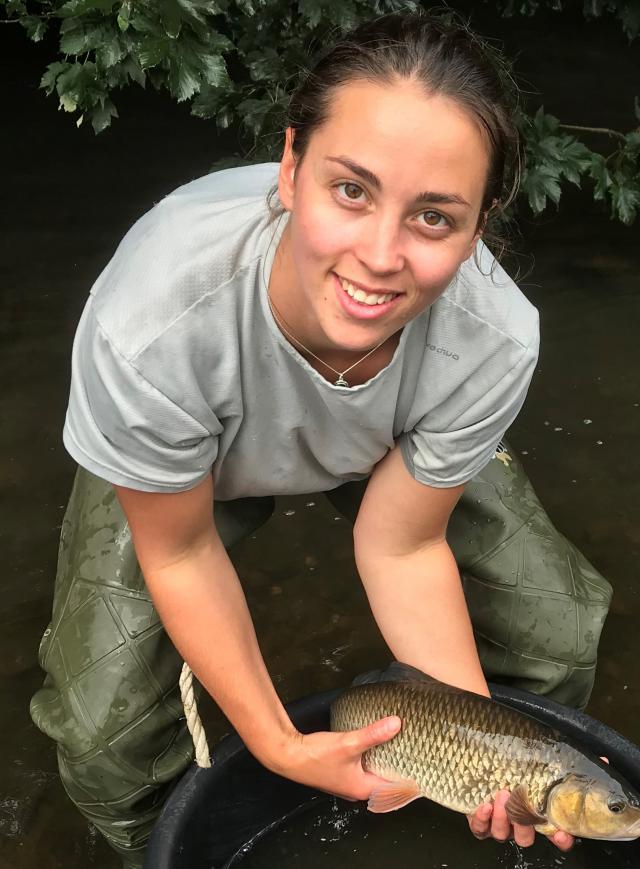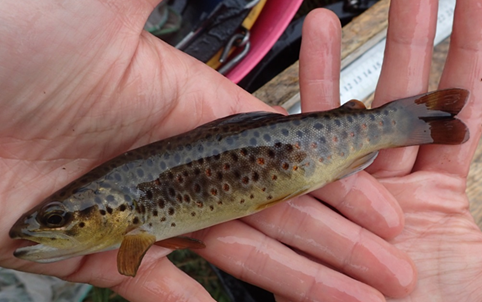Impacts of acidification on Brown trout populations in Southwest Scotland

25th Jun 2019
by Courtney Rowland
A paper just published in the leading peer-reviewed Journal of Fish Biology looks at the current numbers and genetic diversity of Brown trout populations in Southwest Scotland.

The study was carried out by a team from the School of Biological Sciences, Queen’s University Belfast, led by Professor Paulo Prodöhl and Professor Emeritus Andy Ferguson, who now lives in the area. It also involved renowned local fish artist Robin Ade and many expert anglers, especially Colin and Margaret Roberts. Marine Scotland, Freshwater Laboratory, provided reference material from the detailed surveys that they carried out in the area in the 1980s and 1990s. The study examined more than 2400 brown trout specimens from 23 lochs and six of the larger river systems, mainly in the Galloway Forest Park and adjacent Forrest Estate. Trout fin clips were taken for detailed DNA analyses, with the resultant data being analysed by modern statistical methods.
Southwest Scotland was one of the areas worst affected by acidification in the latter part of the 20th Century. By the 1970s five brown trout populations were thought to have become extinct as no trout were caught in netting surveys, and numbers were shown to be considerably reduced in many others. Following reductions in sulphur and nitrogen industrial emissions in the 1980s the pH increased again suggesting that the lochs might once more be capable of supporting trout populations. Restoration stocking was carried out in these lochs since natural recolonisation could not occur due to impassable waterfalls. One of the lochs, Loch Fleet, was the subject of major international investigations of the feasibility of reducing acidity through liming prior to restoration stocking. All five lochs, although still chronically acidic, now have substantial self-sustaining populations. All other lochs examined in the area also now have flourishing brown trout populations with angler catch rates ranging from 1 to 20 trout per hour, with, as expected, size being inversely proportional to catch rate.
Specific details of the key findings and conclusions are summarised below.
1. A survey and sampling of brown trout in 23 lochs and six main river systems in Southwest Scotland, mainly in the Galloway Forest Park and adjacent Forrest Estate, was carried out during the period 2010-2012. Trout tissue specimens (fin clips) were subsequently used for detailed DNA analyses with the resultant data being analysed by modern statistical methods.
2. Five lochs (Lochs Enoch, Fleet, Narroch, Neldricken and Valley) where brown trout were thought to have become extinct due to acidification, as no trout were caught in surveys in the 1970s and 1980s, now have self-sustaining populations.
3. The current population in Loch Enoch is solely the result of restoration-stocking with Loch Grannoch offspring, with subsequent Enoch offspring being used to re-establish trout in Loch Narroch.
4. Loch Fleet brown trout show evidence of descent from all three sources used for restoration-stocking. Translocated juvenile trout from downstream Little Water of Fleet, below the impassable water fall, showed very limited contribution, possibly reflecting that they could have been sea trout offspring. Similarly trout from Solway Fish Farm (derived originally from Loch Leven, Kinross) had little impact in spite of many hundreds of fish of various ages being stocked. This low survival and reproduction is typical of Farm trout. Hatchery-reared offspring of wild trout from nearby Loch Dee were the largest contributor to the current stock. Loch Grannoch trout offspring were also a major contributor, especially to the more acidified outlet population. This significant contribution was in spite of less than one thousand Grannoch trout eggs being placed in the inlet and outlet streams to measure survival and not for the deliberate purpose of reintroduction.
5. Loch Fleet now has genetically distinct inlet and outlet trout populations, with sub-populations of the latter likely spawning on the adjacent loch shore. Genetic differentiation between inlet and outlet populations probably arose due to differential contribution of genetically distinct ancestors, with precise natal homing serving to maintain these differences.
6. Existing trout populations in adjacent Lochs Neldricken and Valley are mainly the result of the expansion, when conditions improved, of a small remnant population that survived in Neldricken and then colonised Valley downstream. The current populations showing some admixture from the stocking of Loch Grannoch offspring.
7. Brown trout survived in Loch Grannoch, albeit in low numbers, even though a low of pH 4.2 was reached in the 1970s. This represents very acid conditions and below pH 4.5 that is generally regarded as the minimum pH where trout can survive. The unusual survival here is likely due to the trout having evolved a heritable tolerance of low pH conditions, and this adaptation is probably responsible for the success of stocking with Grannoch offspring in other lochs, which, while showing improved conditions, are still chronically acidified.
8. DNA analyses showed Loch Grannoch trout to be the genetically most distinct in the area, even from Loch Dee trout only 5 km away on the same river system. Grannoch also showed three genetically distinct brown trout populations, probably representing trout arising from the three main spawning rivers. The genetic differentiation of these populations was likely enhanced by low numbers in the 1970s and 80s promoting random genetic divergence.
9. Loch Mannoch brown trout were shown to be genetically very similar to brown trout from Loch Leven, the broodstock source for the two main Scottish trout farms established in the late 19th Century. After it was created by damming in 1919, the loch was likely stocked with one of these Farm trout strains. Given its genetic similarity to Leven, the trout population in Mannoch forms a potential refuge population should the Leven trout population become endangered, as it has in the past.
10. Records show that limited supplemental-stocking (i.e. stocking where a native population is already present) with Loch Leven-derived Farm strain trout was carried out in the past in some lochs and rivers. However, unlike populations in some other areas of Britain, there is little or no indication of ‘Leven farm genes’ today with most populations showing a purely native genetic profile. An exception is the River Girvan, where Farm strain stocking was undertaken until recently.
11. Angling records show that brown trout numbers increased tenfold in the 1990s and early 2000s in Lochs Round Glenhead and Valley when pH and other environmental conditions improved. Similar increases likely occurred in other lochs and angling catch rates ranged from one to 20 trout per hour in these lochs during the study. Size was inversely proportional to catch rate, as expected from the greater competition for food when numbers are higher.
12. Reductions in brown trout numbers in many isolated hill lochs in Southwest Scotland led to reductions in genetic diversity but resulted in increased genetic differentiation among populations. These populations are now among the most genetically differentiated brown trout populations in Northwest Europe. While much of this differentiation is likely due to random changes resulting from small populations, published studies indicate that such populations are of high conservation importance as they have adapted to unique conditions.
13. The Loch Grannoch trout population was identified as the genetically most distinctive one in the area. This, taken together with its unique increased tolerance to acid conditions, means that statutory conservation measures should be put in place, for example by designation of the Loch as a Site of Special Scientific Interest. Climate change predictions are for an increase in freshwater acidity and thus Grannoch trout may be an important resource for rescuing other trout populations in the future.
14. Many other upland brown trout populations in Southwest Scotland are of high conservation value in a local, national and international context. They are also of key scientific value for studying fundamentals of trout biodiversity especially based on the restored populations of known origins.
15. There is considerable scope for increased trout angling in many of the lochs. However, for long-term protection, and to facilitate greater angler access and responsibility, detailed management plans need to be put in place first.
If you would like to read the full paper, click this link.
Further Information
Latest News
Sticklebacks returned to Buittle Reservoir
3-spined sticklebacks have been introduced to Buittle Reservoir following the eradication of signal crayfish using poison
Celebrating World Ocean Day
To celebrate our river and oceans the GFT team joined other conservation organisations for a World Oceans Day extravaganza held in Port Williams harbour!
Learning on the River Dee with Kells Primary School!
On Friday morning Jess, our Prioritised Salmon Habitat Restoration Officer, was joined along the banks of the River Dee by the enthusiastic pupils of Kells Primary School. This term the pupils of Kells Primary are learning all about Scottish nature.